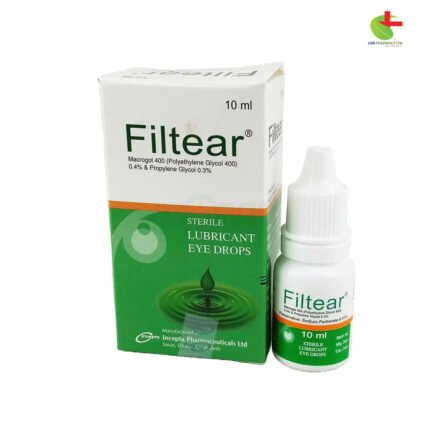Lotepro G Eye Drop
250.00৳ Drop (5ml)
- This ophthalmic suspension is indicated for steroid-responsive inflammatory ocular conditions, especially where there is a risk of bacterial infection.
- It effectively treats allergies, keratitis, iritis, and postoperative inflammation.
- The formulation combines Loteprednol, a corticosteroid, and Gatifloxacin, an antibacterial agent.
- Precautions include avoiding direct injection into the eye and monitoring intraocular pressure during prolonged use.
- Store at room temperature and use within one month after opening.
 Brand
Brand
|
Incepta Pharmaceuticals Ltd |
|---|---|
 Generics
Generics
|
Loteprednol Etabonate + Gatifloxacin |
 Type
Type
|
Ophthalmic Suspension |
Indications
This ophthalmic suspension is designed for treating inflammatory ocular conditions responsive to steroids, particularly when there is a risk of superficial bacterial infection. It is effective for various inflammatory conditions affecting the palpebral and bulbar conjunctiva, cornea, and anterior segment of the eye. These conditions include allergic conjunctivitis, acne rosacea, superficial punctate keratitis, herpes zoster keratitis, iritis, and cyclitis. Additionally, it is used to manage postoperative inflammation following eye surgery.
Pharmacology
Loteprednol, a corticosteroid, is believed to function by inducing phospholipase A2 inhibitory proteins, known as lipocortins. These proteins help regulate the production of key inflammatory mediators, such as prostaglandins and leukotrienes, by inhibiting the release of arachidonic acid from its common precursor. Arachidonic acid is released from membrane phospholipids through the action of phospholipase A2.
Gatifloxacin, an 8-methoxyfluoroquinolone, exhibits antibacterial properties through the inhibition of DNA gyrase and topoisomerase IV. DNA gyrase is crucial for bacterial DNA replication, transcription, and repair, while topoisomerase IV plays a significant role in separating chromosomal DNA during bacterial cell division. The action of gatifloxacin differs from that of aminoglycosides, macrolides, and tetracycline antibiotics, which allows it to target bacteria resistant to these other antibiotic classes. Gatifloxacin has demonstrated effectiveness against various organisms, both clinically and microbiologically.
Aerobic Gram-Positive Bacteria:
- Staphylococcus aureus
- Staphylococcus epidermidis
- Streptococcus mitis group
- Streptococcus oralis
- Streptococcus pneumoniae
Aerobic Gram-Negative Bacteria:
- Haemophilus influenza
Dosage & Administration
Instill one or two drops of the sterile ophthalmic suspension into the conjunctival sac of the affected eye(s) every four to six hours. For the first 24 to 48 hours, you may increase the dosing frequency to every one to two hours. Gradually reduce the frequency as clinical signs improve. It’s important to avoid premature discontinuation of the treatment.
Please follow your doctor’s advice regarding medication usage.
Interaction
Currently, no drug interactions have been reported. If multiple eye medications are to be applied, ensure an interval of at least five minutes between each application.
Contraindications
This sterile ophthalmic suspension is contraindicated for most viral infections of the cornea and conjunctiva, including epithelial herpes simplex, mycobacterial eye infections, and fungal ocular diseases. It should not be used in individuals with known hypersensitivity to any ingredient in this formulation or those with a history of hypersensitivity to other quinolones, acetylsalicylic acid, or non-steroidal anti-inflammatory drugs.
Side Effects
Adverse reactions associated with steroid/anti-infective combination therapies can be linked to either the steroid or the anti-infective component, or both. Potential reactions from ophthalmic steroids include elevated intraocular pressure (IOP), which may lead to optic nerve damage, visual acuity and field defects, posterior subcapsular cataracts, delayed wound healing, secondary infections from pathogens such as herpes simplex, and globe perforation in cases of corneal or scleral thinning. Common side effects of gatifloxacin, occurring in approximately 5-10% of patients, include conjunctival irritation, increased tear production, keratitis, and papillary conjunctivitis. Less frequently reported side effects (1-4%) include chemosis, conjunctival hemorrhage, dry eyes, discharge, irritation, pain, eyelid swelling, headaches, redness, reduced visual acuity, and taste disturbances. Redness was the most commonly reported adverse event at 6%, while itching, discharge, photophobia, and blurred vision were noted in less than 2% of cases.
Pregnancy & Lactation
Pregnancy Category C. There are no adequate and well-controlled studies in pregnant women. This medication should only be used during pregnancy if the potential benefits justify any risks to the fetus. It is unknown if this drug is excreted in human milk; therefore, caution is advised when administered to nursing mothers.
Precautions & Warnings
The preparation should never be injected sub-conjunctively or introduced directly into the anterior chamber of the eye. If Lotepro G is used for ten days or longer, monitoring of intraocular pressure is recommended. Consider potential fungal infection in cases of persistent corneal ulceration where steroids are being used. If symptoms such as redness or itching worsen, patients should consult a physician. Those wearing soft contact lenses and experiencing no redness should wait at least ten minutes after instillation before inserting their lenses.
Therapeutic Class
Ophthalmic Steroid Preparations
Storage Conditions
Store at room temperature and protect from light. Avoid touching the dropper tip to any surface. The contents should not be used more than one month after the bottle is first opened. Protect from freezing.













Reviews
There are no reviews yet.